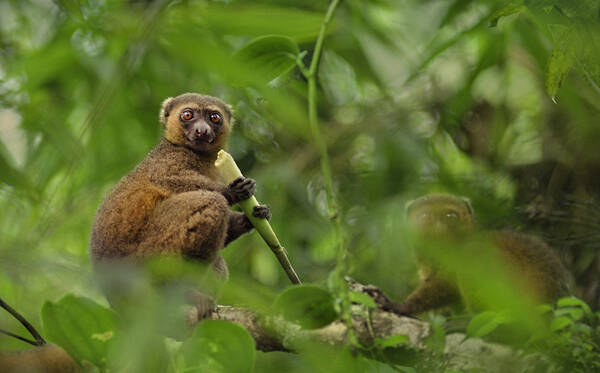Hapalemur aureus
IUCN
LCBasic Information
Scientific classification
- name:Hapalemur aureus
- Scientific Name:Hapalemur aureus,Golden Lemur
- Outline:Primates
- Family:Lemuridae lemur
Vital signs
- length:28-45cm
- Weight:1-1.5kg
- lifetime:No verification information
Feature
Golden eyebrows, cheeks and throat, light orange fur on back with grey to brown guard hairs
Distribution and Habitat
The golden bamboo tame lemur is a species endemic to Madagascar. The golden bamboo tame lemur was first discovered by Western scientists in southeastern Madagascar in 1987, in Ranomafana National Park, and was discovered in Andringitra Nature Reserve in 1993.
It mainly lives in the humid tropical rainforests and bamboo forests of Madagascar.
Appearance
The Golden Bamboo Tamer is a small lemur, 52-85 cm long from head to tail, 28-45 cm long from head to body, and weighs 1-1.5 kg, about the size of a kitten. The fur on the back is light orange with gray to brown guard hairs, and the underparts are yellow. The cheeks are black, with a very short muzzle, golden eyebrows, cheeks and throat, and short furry ears. Males and females usually have a similar appearance, but females tend to be slightly grayer on the upper body.
Details
Golden Bamboo Lemur (scientific name: Hapalemur aureus) is a small lemur.

Golden Bamboo Lemurs live in groups, with 2-6 members, usually 3 or 4, including a pair of adult lemurs, several sub-adult lemurs and lemur cubs. They live in a rainforest with dense bamboos and are active by nature, moving an average of about 400 meters a day.
The golden bamboo lemur mates in July and August every year. The gestation period of the female monkey is about 138 days. It gives birth in November and December, with 1-2 babies per litter. The mother monkey will hide the babies in a secret place for the first two weeks after they are born. After 6 months, the baby monkeys are weaned and live with the tribe. Female golden bamboo lemurs leave the group and find another home at the age of 3.
About 2000 years ago, the first immigrants on the island of Madagascar began to cut down trees, reclaim farmland, and raise livestock. Today, the area of rainforest in Madagascar has shrunk by nearly 80%, seriously threatening the survival of various local lemurs. However, the slight forest destruction has benefited the golden bamboo lemurs a lot, because the appropriate amount of forest felling has made room for the growth of bamboo, which has virtually increased the distribution density of natural bamboo forests.
Listed in the 2008 Red List of Endangered Species of the World Conservation Union (IUCN) ver 3.1 - Critically Endangered (CR).
Listed in the CITES Appendix I of the Washington Convention as a protected animal.
Protect wild animals and eliminate game.
Maintaining ecological balance is everyone's responsibility!








